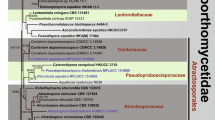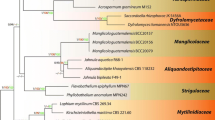Abstract
Four new helicoid anamorphic fungi collected from marine habitats in Egypt and Japan are described. Three marine and one terrestrial Cirrenalia species along with two Cumulospora species and the four new fungi were sequenced for LSU and SSU rDNA. Phylogenetic analyses of the generated sequences, along with those from GenBank, confirmed the polyphyly of the genera Cirrenalia and Cumulospora, and new genera are erected to accommodate the displaced species. Eight new genera, four new species and six new combinations are made: 1. Halazoon anam.-gen. nov. (Halazoon melhae sp. nov., H. fuscus for Cirrenalia fusca), 2. Moheitospora anam.-gen. nov. (Moheitospora fruticosae sp. nov., M. adarca for Cirrenalia adarca), 3. Moleospora anam.-gen nov. (Moleospora maritima sp. nov.), and 4. Glomerulispora anam.-gen. nov. (Glomerulispora mangrovis sp. nov); Cirrenalia pygmea, Cirrenalia tropicale and Cumulospora varius are transferred to the new genera, 5. Hydea anam.-gen. nov, 6. Matsusporium anam.-gen. nov., and 7. Moromyces anam.-gen. nov., respectively. These genera can be assigned to the order Lulworthiales, TBM (Torpedospora/Bertia/Melanospora) clade, while Cirrenalia macrocephala is nested within the order Halosphaeriales. Few morphological characters delineate the genera and species assigned to the Lulworthiales and this aspect is discussed in relation to the molecular data. The phylogenetic position of the terrestrial species, Cirrenalia japonica, shows that it is a member of the order Pleosporales, and a new genus, 8. Hiogispora anam.-gen. nov. is proposed for the fungus.














Similar content being viewed by others
References
Abdullah SK, Abdulkadder MA, Goos RD (1989) Basramyces marinus nom. nov. (hyphomycete) from southern marshes of Iraq. Int J Mycol Lichen 4:181–186
Bills GF, Platas G, Peelaez F, Masurekar P (1999) Reclassification of a pneumocandin-producing anamorph, Glarea lozoyensis gen. et sp. nov., previously identified as Zalerion arboricola. Mycol Res 103:179–192
Bunyard BA, Nicholson MS, Royse DJ (1994) A systematic assessment of Morchella using RFLP analysis of the 28S rRNA gene. Mycologia 86:762–772
Campbell J, Volkmann-Kohlmeyer B, Gräfenhan T, Spataofora JW, Kohlmeyer J (2005) A re-evaluation of Lulworthiales: relationships based on 18S and 28S rDNA. Mycol Res 109:556–568
Chatmala I, Sakayaroj J, Somrithipol S, Phongpaichit S (2004) Marine hyphomycetes of Thailand and Cumulospora varia sp. nov. Fung Diver 17:1–9
Felsenstein J (1981) Evolutionary trees from DNA sequences: a maximum likelihood approach. J Mol Evol 17:368–376
Felsenstein J (1985) Confidence limits on phylogenies: an approach using the bootstrap. Evolution 39:783–791
Goos RD (1985) On the anamorph genus Cirrenalia. Pro Ind Acad Sc (Plant Science) 94:245–252
Goos RD (1987) Fungi with twist: the helicosporous hyphomycetes. Mycologia 79:1–22
Huelsenbeck JP, Ronquist F (2001) MRBAYES: Bayesian inference of phylogeny. Bioinformatics 17:754–755
Hyde KD, Goh TK, Lu BS, Alias SA (1999) Eleven new intertidal fungi from Nypa fruticans. Mycol Res 103:1409–1422
Jiang YL, Zhang TY (2007) Two new species of Cirrenalia from soil. Mycotaxon 101:65–68
Jones EBG (1994) Fungal adhesion. Presidential address 1992. Mycol Res 98:961–981
Jones EBG, Pilantanapak A, Chatamala I, Sakayaroj J, Phongpaichit S, Choeyklin R (2005) Thai marine fungal diversity. Songklanakarin J Sc Tech 28:687–708
Jones EBG, Klaysuban A, Pang KL (2008) Ribosomal DNA phylogeny of marine anamorphic fungi: Cumulospora varia, Dendryphiella species and Orbimyces spectabilis. Raff Bull Zool Suppl 19:11–18
Jones EBG, Sakayaroj J, Suetrong S, Somrithipol S, Pang KL (2009) Classification of marine Ascomycota, anamorphic taxa and Basidiomycota. Fung Diver 35:1–189
Kirschner R, Piepenbring M, Chen CJ (2004) Some cercosporoid hyphomycetes from Taiwan, including a new species of Stenella and new reports of Distocercospora pachyderma and Phacellium paspali. Fung Diver 17:57–68
Koch J, Pang KL, Jones EBG (2007) Rostrupiella danica gen. et sp. nov., a Lulworthia-like marine lignicolous species from Denmark and the USA. Bot Mar 50:1–8
Kohlmeyer J (1958) Beobachtungen über mediterrane Meerespilze sowie das Vorkommen von marinen Moderfäule-Erregern in Aquariumszuchten holzzerstörender Meerestiere. Ber Dtsch Bot Ges 71:98–116
Kohlmeyer J, Kohlmeyer E (1979) Marine mycology: the higher fungi. Academic, New York
Kohlmeyer J, Volkmann-Kohlmeyer B, Eriksson OE (1997) Fungi on Juncus roemerianus 9. New obligate and facultative marine Ascomycotina. Bot Mar 40:291–300
Matsushima T (1980) Saprophytic microfungi from Taiwan. Part I. Matsushima Mycological Memoir No. 1. Published by the author, Kobe, Japan.
Matsushima T (1996) Matsushima Mycological Memoir No. 9. Published by the author, Kobe, Japan.
Mel’nik VA (1988) New species of Hyphomycetes and Coelomycetes from collections in the Altai Mountains and Soviet Far East. Mikol Fitopatol 22:492–502
Meyers SP, Moore RT (1960) Thalassiomycetes II. New genera and species of Deuteromycetes. Am J Bot 47:345–349
Nakagiri A (1984) Two new species of Lulworthia and evaluation of genera-delimiting characters between Lulworthia and Lindra (Halosphaeriaceae). Trans Mycol Soc Jap 25:377–388
Nylander JAA (2004) MrModeltest v2. Program distributed by the author. Evolutionary Biology Center, Uppsala University, Uppsala
Posada D, Crandall KA (1998) MODELTEST: testing the model of DNA substitution. Bioinformatics 14:817–818
Raghu-Kumar S, Zainal A, Jones EBG (1988) Cirrenalia basiminuta: a new lignicolous marine Deuteromycete from the tropics. Mycotaxon 31:163–170
Rambaut A (1999) Se-Al. Department of Zoology, University of Oxford, Oxford OX1 4JD, U. K. http://evolve.zoo.ox.ac.uk/Se-Al/Se-Al.html.
Rao V, Reddy KA (1978) Some new microfungi from India. Ind J Mycol Res 16:301–309
Ronquist F, Huelsenbeck JP (2003) MRBAYES 3: Bayesian phylogenetic inference under mixed models. Bioinformatics 19:1572–1574
Schoch CL, Sung GH, Volkmann-Kohlmeyer B, Kohlmeyer J, Spatafora JW (2006) Marine fungal lineages in the Hypocreomycetidae. Mycol Res 110:257–263
Schmidt I (1969) Carbosphaerella pleosporoides gen. nov. et spec. nov. und Cirrenalia fusca spec. nov., zwei neve marine Pilzarten von der Ostseekuste. Fedd Rep 80:107–112
Schmidt I (1985) Types and type collections of new higher marine and freshwater fungi from the Baltic coast. Mycotaxon 24:419–421
Shenoy BD, Jeewon R, Hyde KD (2007) Impact of DNA sequence-data on the taxonomy of anamorphic fungi. Fung Diver 26:1–54
Somrithipol S, Chatmala I, Jones EBG (2002) Cirrenalia nigrospora sp. nov. and C. tropicalis from Thailand. Nova Hedwigia 75:477–485
Swofford DL (2002) PAUP: phylogenetic analysis using parsimony, version 4.0b10. Illinois Natural History Survey, Champion, Illinois
Sugiyama J (1981) Microfungi Japonicae I. Nova species Cirrenalia in Cortice Abietis homolepsis. Trans Mycol Soc Jpn 22:47–53
Sutton BC (1973) Hyphomycetes from Manitoba and Saskatchewan. Mycol Pap 132:1–143
Thompson JD, Gibson TJ, Plewniak F, Jeanmougin F, Higgins DG (1997) The ClustalX windows interface: flexible strategies for multiple sequence alignment aided by quality analysis tools. Nucl Acids Res 25:4876–4882
Tsui CKM, Berbee ML (2006) Phylogenetic relationships and convergence of helicosporous fungi inferred from ribosomal DNA sequences. Mol Phylog Evol 39:587–597
Vilgalys R, Hester M (1990) Rapid genetic identification and mapping of enzymatically amplified ribosomal DNA from several Cryptococcus species. J Bacteriol 172:4238–4246
White TJ, Bruns TD, Lee SB, Taylor JW (1990) Analysis of phylogenetic relationships by amplification and direct sequencing of ribosomal DNA genes. In: Innis MA, Gelfand DH, Sninsky JJ, White TJ (eds) PCR protocols: a guide to methods and applications. Academic, San Diego, pp 315–322
Zhao GZ, Liu XZ (2005) A review of Cirrenalia (hyphomycetes) and a new species. Fung Diver 18:201–209
Zhao GZ, Liu XZ, Wu WP (2007) Helicosporous hyphomycetes from China. Fung Diver 26:313–524
Acknowledgements
This work was funded by grants from the Japan Society for the Promotion of Science (JSPS) (No. 185701000001 and No. 18-06620). M.A. Abdel-Wahab is grateful to JSPS for an award of a postdoctoral fellowship. Sohag University is acknowledged for providing funds for collecting samples from the field. M.A. Abdel-Wahab is grateful to the Third World Academy of Science (TWAS) for awarding a research grant (No. 03-117 RG/BIO/AF/AC). K.L. Pang would like to thank National Science Council of Taiwan for a research grant (NSC-98-2621-B-019-002-MY3) and Centre of Marine Biology and Biotechnology (CMBB), National Taiwan Ocean University for providing financial support. E.B.G. Jones acknowledges support from the TRF/BIOTEC Special Programme for Biodiversity and Training grant BRT R._251006. We are very grateful to Prof. Uwe Braun, Martin-Luther Universität, Germany, for revising the Latin description.
Author information
Authors and Affiliations
Corresponding author
Rights and permissions
About this article
Cite this article
Abdel-Wahab, M.A., Pang, KL., Nagahama, T. et al. Phylogenetic evaluation of anamorphic species of Cirrenalia and Cumulospora with the description of eight new genera and four new species. Mycol Progress 9, 537–558 (2010). https://doi.org/10.1007/s11557-010-0661-x
Received:
Revised:
Accepted:
Published:
Issue Date:
DOI: https://doi.org/10.1007/s11557-010-0661-x




